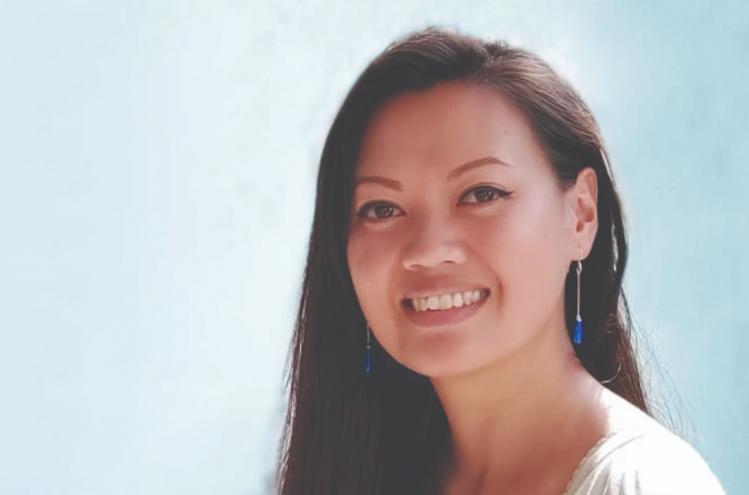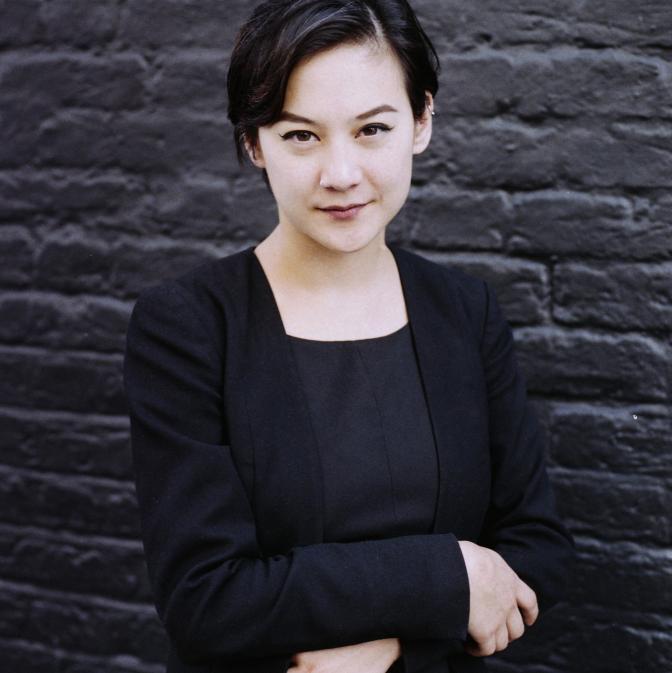
Like all memoirists, Ly Tran accesses her past through hazy and incomplete memories. The first chapter of her debut, House of Sticks, opens with Tran being treated for hypothermia in a New York City hospital because her family, recently arrived from Vietnam, has spent their first American winter in an unheated apartment. Three-year-old Tran and her brothers are chasing each other around the hospital room when “someone falls down and [cries], quite possibly me.” This scene, and the rest of Tran’s book, vividly depicts the challenges of her family’s immigration alongside her own developing American identity and independence.
With every story, Tran is transparent about what cannot be fully remembered. Her earliest memories are seen through a scrim of buoyant curiosity and delight, making the family’s in-home sweatshop labor feel like a game, and even softening their dire poverty and isolation. But there are other devastating reasons Tran struggles to see the past, one of them quite literal. Her eyesight begins to decline in third grade, a condition that her father dismisses. “No young person should be wearing glasses, and especially not my children,” he scoffs when she brings home a note from her school nurse. “Once you put on glasses, you’ll be blind forever.” In one of many episodes where her father loses himself to paranoia and rage, he beats and berates Tran for daring to ask for glasses. His eruptions, we learn, are rooted in his decade spent as a prisoner in a North Vietnamese reeducation camp. While conveying her father’s violence with visceral fear and confusion, Tran’s writing is also unfailingly tender toward him. What she wants most is to take away his trauma and its specter, which lives like an extra family member in their tiny Queens apartment.
Around the time she begins losing her eyesight, Tran also begins to dissociate, experiencing a split from herself that haunts the rest of her story. “I started making faces to see if I could find one that squared with who I thought I was, unable to shake the uneasy feeling that I was not the girl I saw in the mirror.” The girl in the mirror terrifies Tran with her unrecognizable face and shames her whenever Tran expresses a desire that doesn’t serve her family. Tran endures this interior split while navigating external ones that also threaten to divide her from her family: her eyesight continues to deteriorate, yet she must protect her parents from the school’s charges that refusing her glasses amounts to child neglect.
Not wanting to anger or betray her mother and father, Tran guards the secret of a sympathetic teacher who buys her glasses and later her eldest brother who, after leaving home, buys her contacts. She keeps many other secrets from her family—her in-school therapy appointments, sexual harassment from customers at their family’s nail salon, her psychic break and failing grades in college, falling in love at nineteen with an older man with a six-year-old son. Concealing so much of herself as she navigates her parents’ fear and her own desire to make her way in the world, comes at the price of her wholeness, which is already fractured and fragile. As she grows into adulthood, the split between Tran and the girl in the mirror grows sharper and more frightening than ever. “Was the whole of my existence summed up in the reflection that I couldn’t recognize as my own? Pressed so close against the glass, I could only see one part of myself at a time, and never the whole. The mirror wasn’t broken, but the result was the same.”
With tenderness and courage, Tran comes to accept her family as they are, for all they have endured and inflicted. Forging her identity while fighting to recognize her own face, voice, and desires, is a harrowing and lonely journey, and yet Tran’s desire for familial closeness never wavers. In the end, words are what help Tran begin reconciling—with her brothers for leaving home, with her mother for never stopping her father’s abuse, and with her father for his terrifying outbursts.
With the help of teachers, therapists, and a loving partner, Tran finds healing in language that makes real her experiences, desires, and interiority, at last animating her whole and real self. She is not only a daughter, sister, or refugee, but all of these, along with American, student, lover, and writer. Out of heartbreaking inherited trauma, Tran discovers joy in new relationships and the grace for one of the most beautiful scenes of parent-child rapprochement I’ve ever read. Her new eyesight lets Tran see, most importantly, “the voice I’d been unable to access all my life...on the page.” Words are strong enough to contain a life’s story, holding together all the fractures in remembering and telling.
Michelle Zauner is also an immigrant’s daughter who must build her identity apart from her Korean mother before she can build it with her. But before they get a chance at an adult relationship, Zauner’s mother dies of stomach cancer at the age of fifty-six. Zauner is twenty-five. In her memoir, Crying in H Mart, her mother’s life, death, and absence forge Zauner’s character with her overwhelming attention, demands, beauty, mystery, and abiding care.
The book’s titular H Mart, a Korean-owned national grocery chain, is where Zauner goes in search of far more than just provisions. The store is “a beautiful, holy place,” where immigrants, international students, interracial families, and grieving daughters come in search of “a piece of home, or a piece of ourselves. We look for a taste of it in the food we order and the ingredients we buy. Then we separate. We bring the haul back to our dorm rooms and suburban kitchens, and we re-create the dish that couldn’t be made without our journey.”
Offering satisfaction for any craving, H Mart is where Zauner can access both her mother’s native language and her love language: “Food was how my mother expressed her love...I can hardly speak Korean, but in H Mart, it feels like I’m fluent.” Despite her descriptions of mouth-watering treats and the store’s popping energy, H Mart is a haunted site, a shipwreck where Zauner comes to excavate “the first chapter of the story I want to tell about my mother...I’m collecting evidence that the Korean half of my identity didn’t die when she did.”

Zauner’s mother will succumb to cancer less than a year after her diagnosis, hardly giving the family time to catch their breath, let alone comprehend their impending loss. With the little time they have left together, Zauner moves back home, desperately hoping her caregiving will bring physical and emotional healing:
I would radiate joy and positivity and it would cure her. I would wear whatever she wanted, complete every chore without protest. I would learn to cook for her—all the things she loved to eat, and I would single handedly keep her from withering away. I would repay her for all the debts I’d accrued. I would be everything she ever needed. I would make her sorry for ever not wanting me to be there. I would be the perfect daughter.
Food had always connected them, transcending resentments and disappointments. But despite hours of shopping and cooking, the first round of chemotherapy leaves Zauner’s mother unable to eat anything. Tension, fear, and old wounds between immigrant mother and her only American daughter make this time of intended closeness fraught, compounded by the ravages of chemo and the intrusive care of well-meaning friends.
Of course, no dish, no matter how delicious or authentic, can save her mother, nor can the most diligent caregiving ease Zauner’s guilt. Like Tran, she feels responsible for erasing a parent’s pain. Every meal, bath, or sleepless night is meant as atonement for all her transgressions and ingratitude, but also for “the love and care I’d taken for granted for so many years.” Seen through the lens of devastating loss, Zauner’s entire life looks like a debt, and her mother’s dying is the repayment period.
The remaining months of her mother’s illness are a whirlwind of precipitous decline and unexpected rally, a terribly timed trip to Korea, and the beautifully hurried wedding of Zauner and her partner of two years. The event and its planning are a blur, like a video played back at high speed. The love, too, is heightened and frantic, as Zauner and her fiance live life in fast-forward to bring her mother the promise of a future she will not inhabit.
After her mother’s death, Zauner travels the globe in search of who she will be without her, crashing into her anguish at every turn. “Sometimes my grief feels as though I’ve been left alone in a room with no doors. Every time I remember that my mother is dead, it feels like I’m colliding with a wall that won’t give.” The answers she finds renew her relationships with those who remain: her father, her new husband, her family in Korea, her own broken heart.
What pierces Zauner most deeply is all the time she and her mother will never have. “What would have been the most fruitful years of understanding were cut violently short, and I was left alone to decipher the secrets of inheritance without its key.” But time, Zauner discovers while throwing her grief into making kimchi, can give life as surely as it can slowly take it.
I had thought fermentation was controlled death. Left alone, a head of cabbage molds and decomposes. It becomes rotten, inedible. But when brined and stored, the course of its decay is altered.... It exists in time and transforms. So it is not quite controlled death, because it enjoys a new life altogether.
We can’t see cabbage becoming kimchi, nor our greatest loss becoming a new kind of love. We can only wait with hope in wisdom and practice, trusting that what we bury will be unearthed transcendent and defiantly alive.
Please email comments to [email protected] and join the conversation on our Facebook page.
Share
Previous Story
Confronting Climate Change
Next Story
Things Get Broken